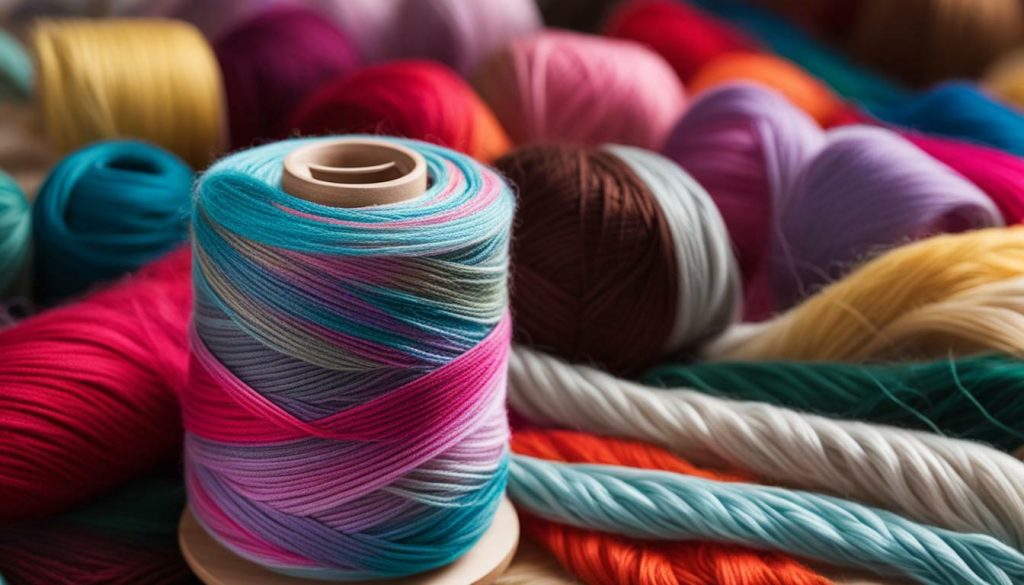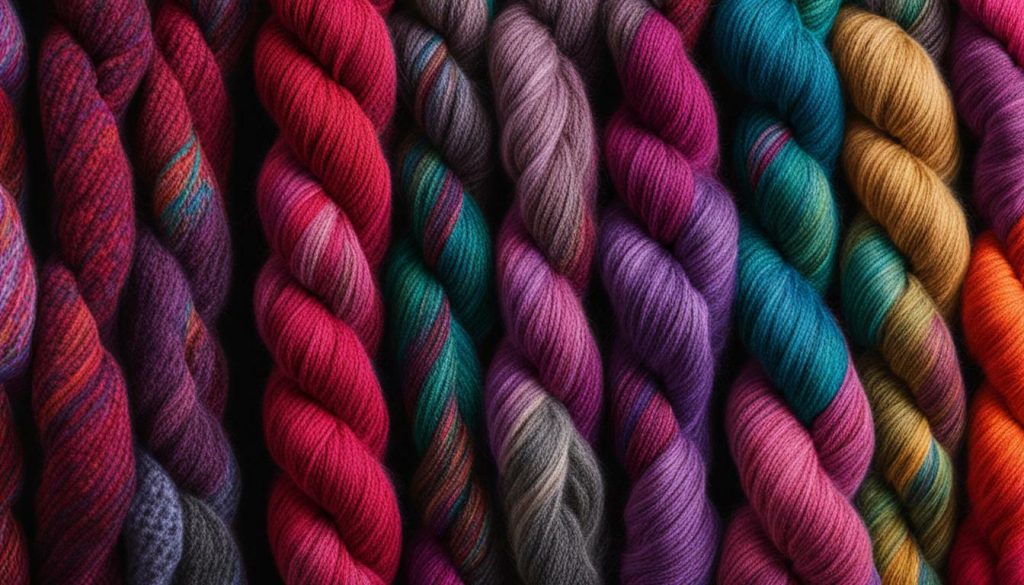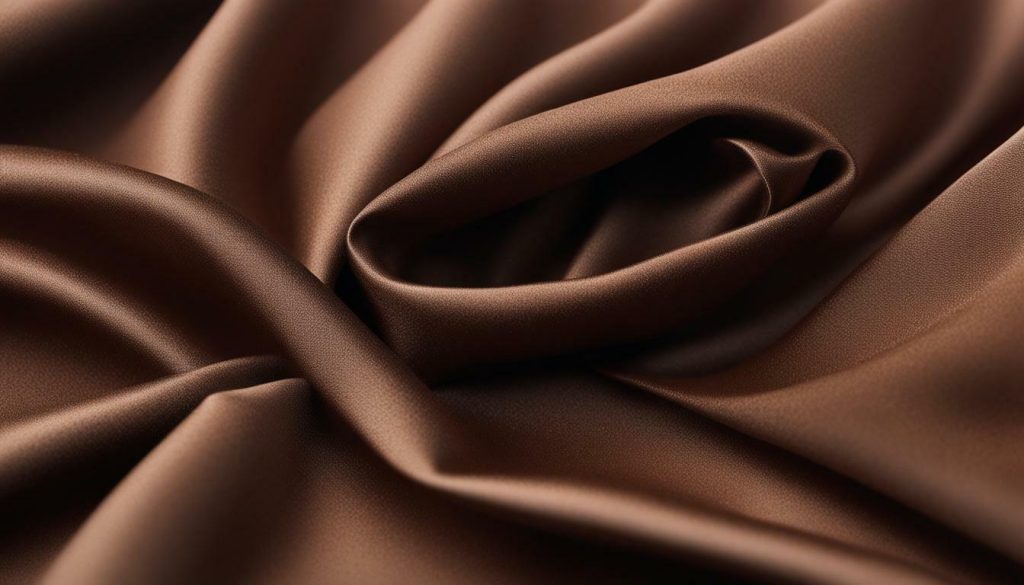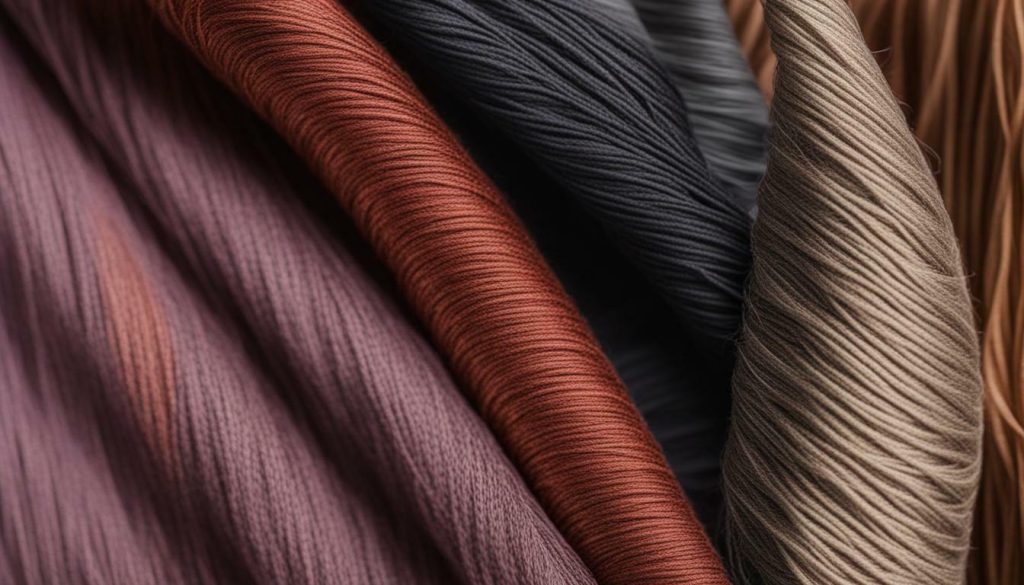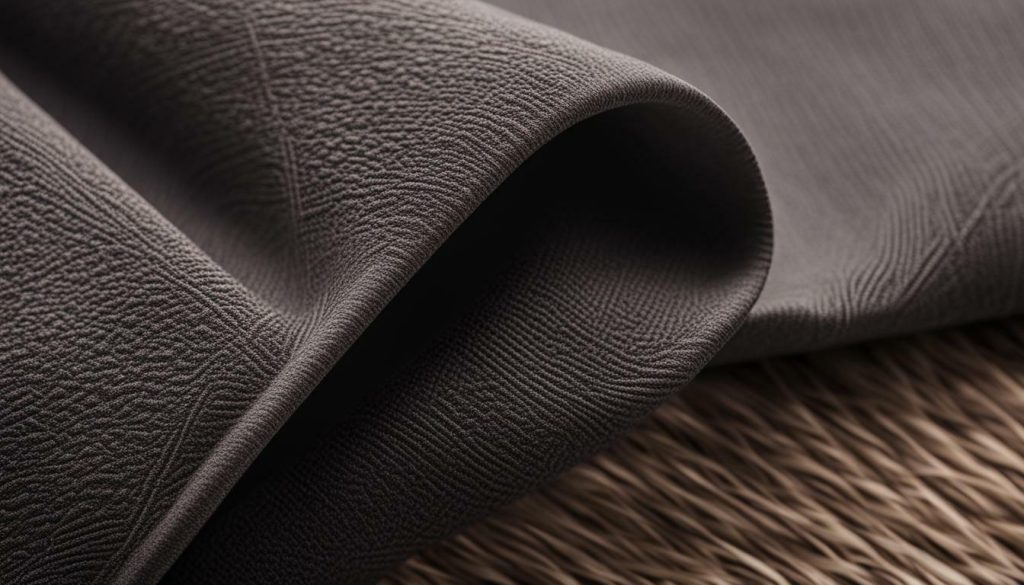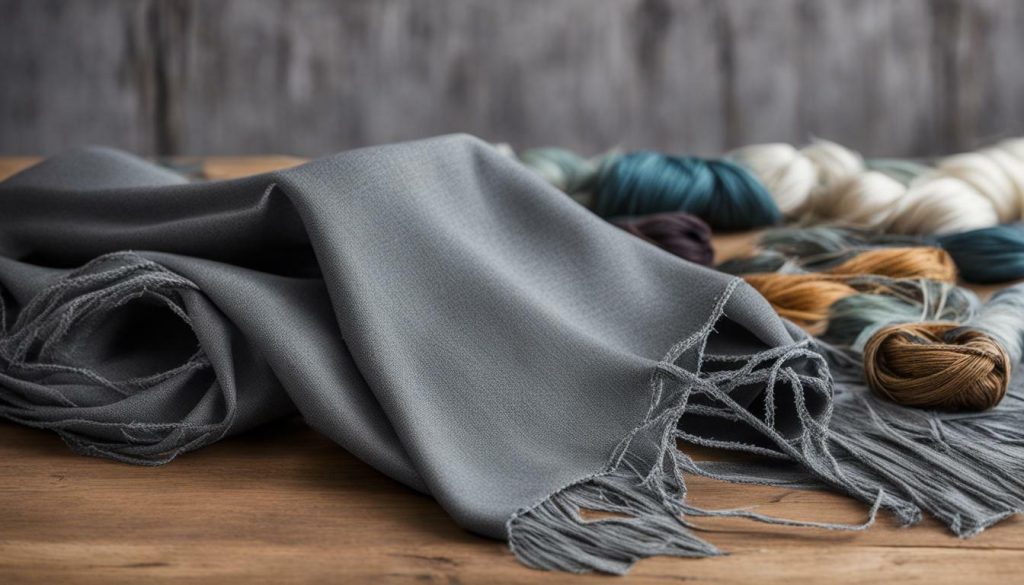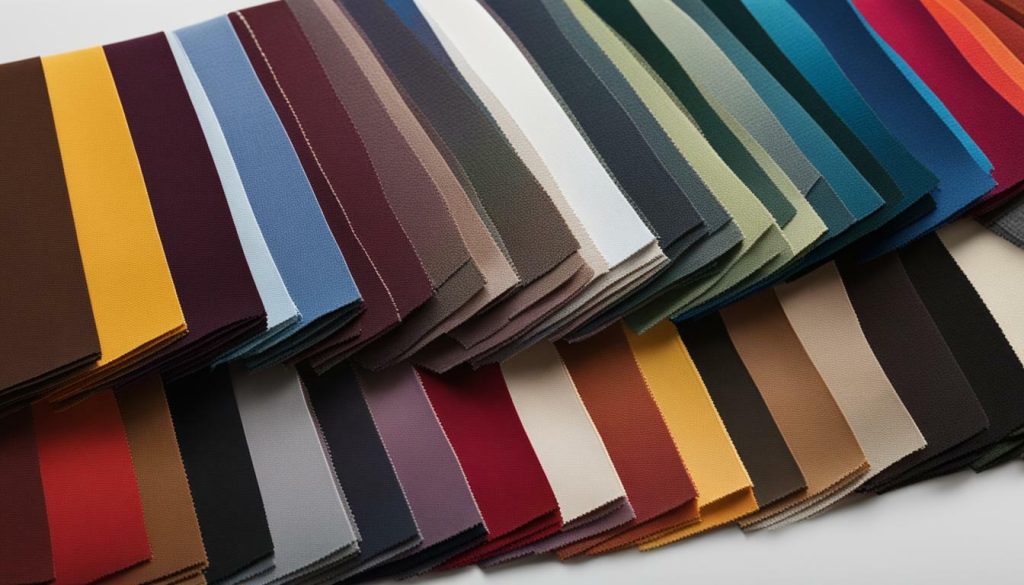
Leggings have become a wardrobe staple for many, but have you ever wondered what they are actually made of? It’s time to dive into the world of leggings and explore the materials that make them so comfortable and versatile.
When it comes to leggings, the predominant material used is acrylic fabric. This fabric is produced from plastic threads that are created through a chemical process using fossil fuels. Acrylic fabric closely resembles wool in terms of look and feel, but it is lighter and softer, making it a popular choice for leggings.
However, it’s important to note that acrylic fabric has its drawbacks. Being hydrophobic, it doesn’t absorb moisture well, which can lead to issues such as bacterial growth and static electricity. Additionally, acrylic fabric is flammable and has a short product lifespan, contributing to long landfill life and environmental concerns.
In an effort to save on material costs, acrylic fiber is often blended with natural fibers. This practice allows for a more affordable product while still maintaining some of the desirable qualities of acrylic fabric.
For those concerned about fraying in acrylic fabric, there are various no-sew techniques that can be used. Some options include using nail polish, burning the edges of synthetic fabric, or using fabric pinking shears.
In summary, when considering leggings materials, it’s important to weigh factors such as comfort, durability, and environmental impact. While acrylic fabric offers softness and resemblance to wool, it also comes with its limitations. Making an informed choice will ensure that your leggings not only look great but also align with your values.
Key Takeaways:
- Leggings are typically made of acrylic fabric, which closely resembles wool in look and feel.
- Acrylic fabric is hydrophobic, leading to issues such as bacteria growth and static electricity.
- Acrylic fabric is flammable and has a short product lifespan, impacting the environment.
- Acrylic fiber is often blended with natural fibers to save on material costs.
- No-sew techniques, such as using nail polish or fabric pinking shears, can prevent fraying in acrylic fabric.
The Rise of Acrylic: Leggings Materials Explained
Acrylic fabric, derived from plastic threads created through a chemical process using fossil fuels, is the most common material used in leggings. This versatile synthetic fiber offers several benefits, making it a popular choice for clothing manufacturers. Acrylic fabric closely resembles wool in terms of look and feel, but it is lighter and softer, providing a comfortable and cozy option for leggings enthusiasts.
However, it’s important to consider some drawbacks of using acrylic fabric in clothing. One major concern is its hydrophobic nature, which means it repels water instead of absorbing it. This can lead to issues such as bacterial growth and static electricity, making acrylic leggings less desirable in certain situations.
Another aspect to keep in mind is the flammability of acrylic fabric. While it may offer warmth and insulation, it can pose a fire risk. This safety concern is particularly important when it comes to clothing, as acrylic fabric can melt and stick to the skin when exposed to high temperatures or flames.
Furthermore, the lifespan of acrylic leggings tends to be shorter compared to garments made from natural fibers. Due to its synthetic composition, acrylic fabric is more prone to pilling, fading, and losing its shape over time. This not only affects the durability of the product but also contributes to increased waste and environmental impact.
Despite these challenges, acrylic fiber is often blended with natural fibers to save on material costs. This practice allows manufacturers to create leggings that have the benefits of both worlds – the affordability and durability of acrylic, combined with the comfort and breathability of natural fibers.
Maintaining the Quality: No-Sew Techniques and Tips
To prevent fraying in acrylic fabric and extend the lifespan of your leggings, there are some no-sew techniques you can try. One method is to apply clear nail polish along the edges of the fabric, acting as a sealant to prevent unraveling. Another option is to carefully burn the edges of the synthetic fabric with a lighter, creating a melted seal. If you prefer a more precise and professional finish, you can use fabric pinking shears to cut the edges of the fabric with zigzag patterns, reducing fraying and adding a decorative touch.
When considering leggings materials, it’s essential to weigh the pros and cons of acrylic fabric. While it offers affordability and a soft texture, its hydrophobic nature, flammability, and shorter product lifespan may be deterring factors. By understanding the characteristics of different leggings materials, you can make an informed choice based on your preferences, comfort, durability, and environmental impact.
| Pros of Acrylic Fabric | Cons of Acrylic Fabric |
|---|---|
| Lightweight and soft | Hydrophobic nature leads to bacterial growth and static electricity |
| Resembles wool in look and feel | Flammable |
| Affordable | Short product lifespan |
| Blends well with natural fibers |
The Look and Feel: Comparing Acrylic to Wool
When you slip into a pair of acrylic leggings, you may notice how they closely mimic the look and feel of wool, but with added comfort. The acrylic fabric used in leggings production is designed to imitate the natural fibers of wool while offering lighter weight and a softer touch. This makes acrylic leggings a popular choice for those seeking the warmth and coziness of wool without the itchiness often associated with it.
The resemblance between acrylic and wool goes beyond their appearance. Like wool, acrylic fabric provides excellent insulation, trapping heat close to the body to keep you warm in cooler temperatures. This makes acrylic leggings a great choice for outdoor activities or layering under skirts and dresses in the winter months.
Furthermore, acrylic fabric has the advantage of being more affordable compared to natural fibers like wool. This cost-effectiveness allows for the production of affordable, stylish leggings that mimic the look and feel of wool while being more accessible to consumers.
| Acrylic Leggings | Wool Leggings |
|---|---|
| Lightweight and soft | Warm and cozy |
| Offers insulation | Provides excellent warmth |
| More affordable | Natural and sustainable |
However, it’s important to note that while acrylic fabric offers several advantages, it also has its drawbacks. For example, acrylic fabric is hydrophobic, meaning it repels water and is not naturally moisture-wicking. This can lead to issues such as bacterial growth and the accumulation of sweat, resulting in an uncomfortable wearing experience. Additionally, acrylic fabric is highly flammable, which poses a safety risk.
In conclusion, acrylic leggings provide a budget-friendly alternative to wool, offering a similar look and feel with added comfort. While they may not possess the same natural properties as wool, acrylic leggings are a popular choice for those seeking a cozy and stylish option. However, it’s essential to consider the drawbacks of acrylic fabric, such as its hydrophobic nature and flammability, before making a purchase decision. Overall, the choice between acrylic and wool leggings depends on personal preferences, budget constraints, and the desired level of sustainability.
Moisture Woes: The Hydrophobic Nature of Acrylic
While acrylic fabric may be cozy, its hydrophobic nature can cause sweat to accumulate, leading to potential bacterial growth and unwanted static cling. Unlike natural fibers such as cotton or wool, which have the ability to absorb and wick away moisture, acrylic fabric repels water, trapping sweat against the skin. This moisture retention creates an environment conducive to bacterial growth, resulting in unpleasant odors and potential skin irritations.
Additionally, the hydrophobic nature of acrylic fabric contributes to the problem of static electricity. As static charges build up on the surface of the fabric, it can lead to clinging and uncomfortable sensations when wearing leggings made of acrylic. This can be especially noticeable during dry seasons or in environments with low humidity.
To mitigate the negative effects of acrylic fabric’s hydrophobicity, it is important to consider other materials when choosing leggings. Natural fibers like cotton or bamboo offer better moisture absorption and breathability, keeping you comfortable and dry throughout the day. Alternatively, leggings with moisture-wicking features or blends that include moisture-absorbing materials can also provide a more suitable option.
Table: Pros and Cons of Acrylic Fabric
| Pros | Cons |
|---|---|
| Soft and lightweight | Hydrophobic – traps moisture |
| Resistant to fading and wrinkles | Prone to pilling and static cling |
| Good color retention | Flammable |
| Low cost | Short product lifespan |
When considering leggings fabric options, it’s essential to keep in mind the potential downsides of acrylic and prioritize materials that offer better moisture management. By opting for leggings made of breathable and moisture-wicking fabrics, you can ensure a comfortable and odor-free experience, reducing the risks associated with acrylic fabric and its hydrophobic nature.
While acrylic fabric boasts softness and lightweight qualities, its hydrophobic nature presents challenges when it comes to moisture. Sweating can lead to bacteria growth and discomfort caused by static cling. However, alternatives such as cotton or moisture-wicking blends can provide improved moisture management, ultimately enhancing the comfort and performance of leggings. Make an informed choice to ensure a delightful and sweat-free experience.
The Fire Risk: Acrylic’s Flammability Factor
It’s important to be aware that acrylic fabric is highly flammable, making it less suitable for certain scenarios where fire hazards may be present. The chemical composition of acrylic fibers, derived from plastic threads, contributes to its flammability. In the event of a fire, acrylic fabric can melt and drip, potentially causing severe burns or spreading the fire further. This characteristic poses a significant safety concern, especially when it comes to clothing.
When considering leggings fabric options, it is essential to prioritize safety and evaluate the potential fire risk associated with different materials. While acrylic fabric may offer comfort and affordability, it may not be the best choice for situations where open flames, sparks, or heat sources are present. It is advisable to opt for leggings made from fire-resistant materials such as wool or cotton, which provide a safer alternative.
Leggings made from natural fibers, such as cotton or wool, have lower flammability compared to acrylic. These materials have higher ignition points, meaning they are more resistant to catching fire and burning. In the case of wool, it naturally contains fire-retardant properties, which can be beneficial in minimizing the risk of flames spreading or garments catching fire.
When it comes to purchasing leggings, it’s crucial to prioritize both style and safety. By choosing fire-resistant materials and avoiding highly flammable fabrics like acrylic, you can ensure that you’re making a wise decision for your wardrobe. And remember, when it comes to fire safety, it’s always better to be cautious and proactive!
| Pros | Cons |
|---|---|
| Lightweight and soft | Highly flammable |
| Affordable | Short product lifespan |
| Resembles wool in look and feel | Hydrophobic nature leads to bacterial growth and static electricity |
| Blending with natural fibers saves on material costs |
A Short-Lived Love Affair: The Lifespan of Acrylic Leggings
Unfortunately, acrylic fabric tends to have a shorter lifespan compared to other materials, contributing to a longer landfill presence. While acrylic leggings may be soft, lightweight, and affordable, they often fail to withstand the test of time. As a synthetic fiber created from plastic threads, acrylic fabric lacks the durability and resilience of natural fibers like cotton or wool.
When it comes to clothing, longevity is key. We want our favorite leggings to go the distance, accompanying us on countless workouts and adventures. But acrylic fabric falls short in this department. It is prone to pilling, stretching, and losing shape with frequent use and washing. This means that, unfortunately, those cozy acrylic leggings you love may need to be replaced more frequently than you’d like.
So, what does this mean for the environment? Well, the shorter lifespan of acrylic leggings results in more waste being sent to landfills. As acrylic is a synthetic material derived from fossil fuels, it does not biodegrade easily. Instead, it persists in the environment for a long time, contributing to pollution and resource depletion. As conscious consumers, it’s essential to consider the environmental impact of our choices, including the materials used in our leggings.
| Pros of Acrylic Leggings: | Cons of Acrylic Leggings: |
|---|---|
| Soft and lightweight | Shorter lifespan |
| Affordable | Poor durability |
| Resembles wool in appearance and texture | Contributes to landfill waste |
| Derived from fossil fuels |
Ultimately, it’s crucial to make informed choices when selecting leggings materials. Consider opting for natural fibers like cotton or wool, which offer greater durability and sustainability. However, if acrylic leggings have captured your heart, there are ways to extend their lifespan. Treat them gently, avoid excessive washing, and handle with care to minimize pilling and stretching. By making conscious decisions and caring for our clothing, we can minimize our impact on the environment and enjoy our leggings for longer.
Blending for Cost: Acrylic and Natural Fiber Combinations
To cut down on material expenses, acrylic fiber is often blended with natural fibers, creating a hybrid fabric for leggings. This allows manufacturers to strike a balance between cost-effectiveness and maintaining the desirable qualities of both fibers. By blending acrylic with natural fibers like cotton or wool, leggings can have improved breathability, moisture-wicking properties, and durability.
One popular combination is acrylic and cotton, which provides the softness and comfort of cotton while benefiting from the lightweight and easy-care properties of acrylic. Blended leggings offer a smooth and stretchy fit, making them ideal for active wear or everyday use.
Another advantage of blending acrylic with natural fibers is the variety of textures and finishes that can be achieved. For example, combining acrylic with wool creates a fabric that has the warmth and insulation of wool, with the added softness and lightweight feel of acrylic. This blend is particularly popular for winter leggings, providing both style and functionality.
Table 1: Comparison of Acrylic Blends
| Blend | Characteristics |
|---|---|
| Acrylic+Cotton | Soft, lightweight, breathable |
| Acrylic+Wool | Warm, insulating, soft |
| Acrylic+Polyester | Durable, moisture-wicking, quick-drying |
However, it is important to note that while blending acrylic with natural fibers can offer advantages, it may also come with some drawbacks. For example, prolonged use may cause pilling or shedding in the fabric due to the acrylic component. Additionally, the percentage of each fiber in the blend will affect the overall characteristics, so it is essential to consider the intended purpose of the leggings and choose the appropriate blend accordingly.
When shopping for leggings, it is worth checking the label or product description to see if they are made from a blended fabric. By understanding the materials used, consumers can make informed decisions based on their preferences and needs. Whether it’s a cozy winter wool blend or a lightweight cotton-acrylic blend for summer workouts, the world of leggings offers a wide range of options to suit different tastes and lifestyles.
Summary:
- Acrylic is often blended with natural fibers to create affordable and versatile leggings fabric.
- Blending acrylic with cotton provides softness and lightweight comfort.
- Combining acrylic with wool offers warmth and insulation for winter leggings.
- Prolonged use may cause pilling or shedding in acrylic-blended fabrics.
- Consider the intended purpose and blend ratio when choosing leggings.
| Blend | Characteristics |
|---|---|
| Acrylic+Cotton | Soft, lightweight, breathable |
| Acrylic+Wool | Warm, insulating, soft |
| Acrylic+Polyester | Durable, moisture-wicking, quick-drying |
Fraying Solutions: No-Sew Techniques and Tips
If you’re faced with fraying edges on your acrylic leggings, fear not! There are simple ways to address this issue without sewing. Whether you’re a DIY enthusiast or just looking for quick fixes, these no-sew techniques will help you keep your leggings looking fresh and prevent further fraying.
1. Nail Polish: One of the easiest and most effective solutions is using clear nail polish. Simply apply a thin layer of nail polish along the frayed edge, allowing it to dry completely. This creates a protective barrier that prevents further fraying. Plus, you can choose a colorless polish, so it won’t be noticeable.
2. Burn Technique: This technique should be approached with caution and only used on synthetic fabrics like acrylic. Carefully hold a lighter or match flame close to the frayed edge, moving it in a swift motion to singe the frayed fibers. Be sure not to hold the flame too close or for too long, as this could cause damage. Always perform this technique in a well-ventilated area and have a fire extinguisher or water source nearby, just in case.
3. Fabric Pinking Shears: These specialized scissors have zigzag-patterned blades that cut fabric in a way that minimizes fraying. Simply trim the frayed edges with the pinking shears to create a neat and finished look. This technique is especially useful for those who want to achieve a more professional finish without the need for sewing.
Remember, prevention is better than cure! To avoid fraying in the first place, always follow the care instructions provided with your leggings. Washing them on a gentle cycle, using a laundry bag, and avoiding harsh detergents can help maintain the integrity of the fabric. Additionally, avoid using fabric softeners, as they can weaken the fibers and increase the chances of fraying.
By utilizing these no-sew techniques and taking proper care of your leggings, you can extend their lifespan and keep them looking as good as new. Say goodbye to frayed edges and hello to stylish, intact leggings!
| No-Sew Technique | Pros | Cons |
|---|---|---|
| Nail Polish | Easy to apply, invisible solution | May require reapplication over time |
| Burn Technique | Quick fix for synthetic fabrics | Requires caution and fire safety measures |
| Fabric Pinking Shears | Creates a professional finish | Requires specialized scissors |
Making the Choice: Considering Leggings Materials
Now that you know the ins and outs of acrylic fabric, you can make more informed decisions when choosing your leggings materials. While acrylic may be inexpensive and widely used, it’s important to consider other options that offer better performance and sustainability.
One alternative to acrylic is organic cotton. This natural fiber is grown without the use of synthetic pesticides or fertilizers, making it more environmentally friendly. Organic cotton leggings are breathable, soft, and hypoallergenic, making them ideal for those with sensitive skin or allergies.
If you’re looking for leggings that provide extra support and stretch, consider fabrics like spandex or nylon. These synthetic materials offer excellent elasticity and shape retention, ensuring a snug fit that moves with your body. Additionally, they are moisture-wicking, helping to keep you dry and comfortable during workouts or everyday wear.
| Material | Advantages | Disadvantages |
|---|---|---|
| Acrylic | – Inexpensive – Resembles wool – Lightweight and soft |
– Hydrophobic – Flammable – Short product lifespan |
| Organic Cotton | – Environmentally friendly – Breathable and soft – Hypoallergenic |
– Less stretch and support |
| Spandex/Nylon | – Excellent elasticity and shape retention – Moisture-wicking |
– Less breathable compared to natural fibers |
When considering leggings materials, it’s important to think about the intended use and your personal preferences. Whether you prioritize sustainability, comfort, or performance, there are various options available to suit your needs. So, next time you’re shopping for leggings, take a closer look at the fabric composition and choose one that aligns with your values and desires.
Conclusion
Leggings, while often made of acrylic fabric, offer both comfort and potential drawbacks, prompting us to consider alternative materials for our activewear needs.
Acrylic fabric, produced from plastic threads created using fossil fuels, closely resembles wool in terms of appearance and texture. It provides a lighter and softer feel, but its hydrophobic nature can lead to issues such as bacterial growth and static electricity.
Furthermore, acrylic fabric is flammable and has a short product lifespan, contributing to long landfill life and environmental concerns. To save on material costs, acrylic fiber is often blended with natural fibers in leggings production.
While there are no-sew techniques to prevent fraying in acrylic and other synthetic fabrics, such as using nail polish, burning edges, or employing fabric pinking shears, it is crucial to consider the overall impact and alternatives when choosing leggings materials.
By taking into account factors like comfort, durability, and environmental impact, we can make informed choices and explore alternative materials that offer both style and sustainability for our activewear needs.
FAQ
Q: What are leggings made of?
A: Leggings are typically made of acrylic fabric, which is produced from plastic threads created through a chemical process using fossil fuels. Acrylic fabric closely resembles wool in terms of look and feel, but it is lighter and softer.
Q: Why is acrylic fabric not ideal for clothing?
A: Acrylic fabric is not ideal for clothing as it is hydrophobic, leading to bacteria growth and static electricity. It is also flammable and has a short product lifespan, contributing to long landfill life.
Q: Is acrylic fiber blended with other materials?
A: Yes, acrylic fiber is often blended with natural fibers to save on material costs in leggings production.
Q: How can fraying in acrylic fabric be prevented?
A: Various no-sew techniques can be used to prevent fraying in acrylic fabric, such as using nail polish, burning the edges, or using fabric pinking shears.
Q: What should be considered when choosing leggings materials?
A: When choosing leggings materials, factors such as comfort, durability, and environmental impact should be taken into account.


